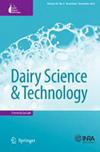乌干达北部和肯尼亚西部典型传统发酵乳的微生物质量
Q2 Agricultural and Biological Sciences
引用次数: 0
摘要
在这项研究中,分析了来自乌干达北部和肯尼亚西部的传统发酵牛奶的微生物质量。在乌干达北部的Karamojong (UG 1)和Acholi (UG 2)以及肯尼亚西部的Kalenjin (KE)的传统养牛人中随机收集了6份典型的传统发酵乳样本。采集样品的微生物质量通过使用常规方法进行好氧嗜中温细菌总数、大肠菌群总数、乳酸菌总数、金黄色葡萄球菌总数、单核增生李斯特菌总数、酵母总数和霉菌总数的评估。平均嗜氧中温细菌计数为5.14 × 109大肠菌群形成单位(cfu)/mL。嗜酸性乳酸杆菌的平均计数为106 ~ 108 cfu/mL。嗜热乳酸杆菌的平均计数为107 ~ 109 cfu/mL,嗜热乳酸球菌的平均计数为106 ~ 109 cfu/mL。另一方面,链球菌计数在106 ~ 108 cfu/mL之间。非山梨醇型大肠杆菌平均计数为3.87 × 103 cfu/mL。这些结果表明,虽然本研究中传统酸奶的pH值较低,但酸度不足以抑制产品中微生物的生长。虽然在挤奶过程中很难避免牛奶的微生物污染,但在奶牛养殖实践中保持非常高的卫生水平是至关重要的,在挤奶过程中正确清洁乳头对于良好的乳房健康和最佳的牛奶质量以及确保安全非常重要。有关微生物污染的结果引起了公众健康问题,因此有关的政府机构必须注意确保生产酸奶的环境处于最佳状态,以减少污染。本文章由计算机程序翻译,如有差异,请以英文原文为准。
Microbiological Quality of Typical Traditional Fermented Milk from Northern Uganda and Western Kenya
In this study, the microbiological quality of traditionally fermented milk from Northern Uganda and Western Kenya was analysed. Six samples of typical traditionally fermented milk were collected randomly from traditional cattle keepers in Karamojong (UG 1) and Acholi (UG 2) in Northern Uganda and Kalenjin in Western Kenya (KE). The microbial quality of the collected samples was assessed through the use of conventional methods for total aerobic mesophilic bacteria, total coliform, lactic acid bacteria, Staphylococcus aureus, Listeria monocytogenes, yeasts, and mould counts. The mean aerobic mesophilic bacterial counts were 5.14 × 109 coliform forming units (cfu)/mL. The mean counts for mesophilic lactobacilli ranged from 106 to 108 cfu/mL. The mean thermophilic lactobacilli count ranged from 107 to 109 cfu/mL, while the mean thermophilic lactococci counts ranged from 106 to 109 cfu/mL. On the other hand, the Streptococci counts were between 106 and 108 cfu/mL. The mean count for the non-sorbitol E. coli was 3.87 × 103 cfu/mL. These results suggest that although the pH of the traditional yoghurt in this study was low, the acidity was not sufficient to inhibit growth of microorganisms in the product. Although it is difficult to avoid the microbial contamination of milk during milking, it is of the utmost importance to maintain a very high level of hygiene in dairy farming practices, and the correct cleaning of teats during milking is very important for good udder health and optimum milk quality, and to ensure safety. The results regarding microbial contamination pose public health concerns, and therefore the appropriate government agencies must pay attention to ensure that the environment in which yoghurt is produced is in the best condition to reduce contamination.
求助全文
通过发布文献求助,成功后即可免费获取论文全文。
去求助
来源期刊

Dairy Science & Technology
农林科学-食品科技
CiteScore
2.30
自引率
0.00%
发文量
0
审稿时长
2 months
期刊介绍:
Information not localized
 求助内容:
求助内容: 应助结果提醒方式:
应助结果提醒方式:


